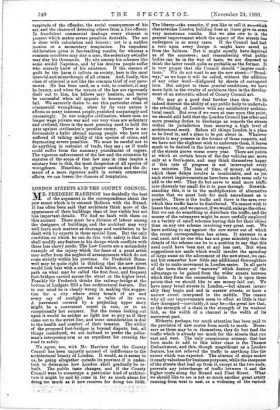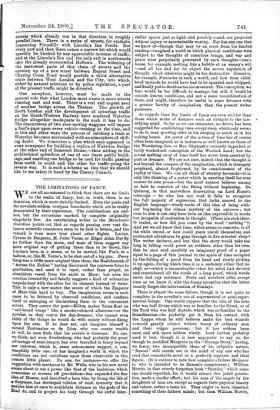LONDON STREETS AND THE COUNTY COUNCIL.
MR. FREDERIC HARRISON has decidedly the best of the argument in the correspondence about the new street which is to connect Holborn with the Strand. It has often been said that architects think more of the appearance of their buildings than of less visible but not less important details. We find no fault with them on this account. There must be a division of labour among the 'designers of buildings, and the architect may very well leave such matters as drainage and ventilation to be dealt with by experts in those special lines. But the only condition on which he can do this with safety is that he shall modify any feature in his design which conflicts with these less showy needs. The Law Courts are a melancholy example of the injury which the fame of a great artist may suffer from the neglect of arrangements which do not come strictly within his province. Sir Frederick Bram- well may be quite right in thinking that the new street would look best with a covered walk below, a second foot- path on what may be called the first floor, and frequent foot-bridges carried across the street at the higher level. Possibly Sir Frederick thinks the railway-bridge at the bottom of Ludgate Hill a fine architectural feature. But to our mind he is clearly wrong in making this sugges- tion for a city where every breath of air and every ray of sunlight has a value of its own. A pavement covered by a projecting upper story might be a convenient resort in rain, or in an exceptionally hot summer. But the rooms looking out upon it would be neither so light nor so airy as if they came out to the street line, and some consideration is due to the health and comfort of their inmates. The utility of the proposed foot-bridges is beyond dispute, but, all things considered, we are inclined to prefer the police- man's interposing arm as an expedient for crossing the road in safety.
We agree, too, with Mr. Harrison that the County Council has been unjustly accused of indifference to the architectural beauty of London. It would, as it seems to us, be going altogether outside its province if it under. took to determine how London shall gradually be re- built. The public taste changes, and if the County Council were to stereotype a particular kind of architec- ture it might by and by come in for as much abuse for doingtoo much as it now receives for doing too little. The liberty—tbe anarchy, if you like to call it sces-whieh characterises London building does at times give us some very monstrous results. But we also owe to it the general improvement which the aspect of the streets has undergone in so many cases. If the Council had had a veto upon every design it might have saved ps from the failures. But it might equally have deprived us of the successes ; and remembering what public bodies can be in the way of taste, we are disposed to think the latter result quite as probable as the former. It is very proper that the Council should "impose condi- tions." We do not want to see the new street—" Broad. way," as we hope it will be called, without the addition of any other word—disfigured by sheets of corrugated iron. But subject to these general conditions, we have more faith in the rivalry of architects than in the develop- ment of an autocratic school of County Council art.
We may go a good deal further than this. • We do indeed distrust the ability of any public body to undertake the rebuilding of London with any satisfactory architec- tural result. But even if we were at ease upon this point, we should still hold that the London Council has other and more pressing duties to discharge as regards the streets within its jurisdiction than securing a high level of architectural merit. Before all things London is a place to be lived in, and a place to be got about in. Whatever merits it may possess in the former of these respects, and we have not the slightest wish to underrate them, it leaves much to be desired in the latter respect. The congestion of the streets grows worse every year. There are points at which at certain hours of the day vehicles can move only at a foot's-pace, and may think themselves happy if this rate of progress is not interrupted every two minutes. The loss of time, of money, of temper, which these delays involve is incalculable, and as yet such street improvements as have been made seem only to add to the evil. They do but serve to send more traffic into channels too small for it to pass through. Notwith- standing this, it is to the multiplication of alternative routes that we must look for such amendment as is possible. There is the traffic and there is the area over which this traffic has to be distributed. We cannot wish to lessen the one, and we cannot, if we would, enlarge the other. But we can do something to distribute the traffic, and the money of the ratepayers might be more usefully employed on a variety of small schemes having this for their object than on any One scheme involving very great cost. We have nothing to say against the new street out of which the recent correspondence has arisen. It answers to -a real need, and no one who has not gone minutely into the details of the scheme can be in a position to say that this need could have been met at any less cost. But when suggestions are made which would involve the spending of large sums on the adornment of the new street, we can- not but remember how little one additional thoroughfare will do to make movement in London easier. In all parts of the town there are "narrows" which destroy all the advantage to be gained from the wider streets between which they form the connecting links. It is upon these points that we should like to see money laid out. We have many broad streets in London,—but almost invari- ably they begin and end in narrow streets, or have a • narrow street interposed in the middle. The reason why all our improvements seem to effect so little is that they disregard—inevitably, it may be—the great law that, as the strength of a chain is the strength of its weakest link, so the width of a channel is the width of its narrowest part.
Hitherto, perhaps, too much attention has been paid to the provision of new routes from north to south. Neces- sary as these may be in themselves, they do but feed the traffic which is already too much for the streets that run east and west. The only conspicuous attempt that has been made to add to this latter class is the Thames Embankment, and this, though magnificent as a London feature, has not relieved the traffic to anything like the extent which was expected. The absence of shops makes it nearly valueless for business purposes, while the steepness of the streets that lead up from it, except at the two ends, prevents any interchange of traffic between it and the higher route along the Strand and Fleet Street. What we should like to see is not so much another great artery running from west to east, as a widening of the various
streets which already run in that direction in roughly parallel lines. There is a series of streets, for example, connecting Piccadilly with Lincoln's Inn Fields. But every now and then there comes a narrow bit which would speedily be blocked by any appreciable increase of traffic, and at the Lincoln's Inn end the only exit is northwards into the already overcrowded Holborn. The widening of the narrowest parts of this chain of streets and the opening up of a new street between Regent Street and Charing Cross Road would provide a third alternative route between West London and the City, into which, either by natural selection or by police regulation, a part of the present traffic might be diverted.
One exception, however, must be made to the general rule that what London most wants is more streets running east and west. There is a real and urgent need of another bridge across the Thames. The growth of South London and the development of suburban traffic on the South-Western Railway have rendered Waterloo Bridge altogether inadequate to the work it has to do. The concurrence of two slow-moving waggons will impose a foot's-pace upon every vehicle crossing at the time, and in this and other ways the process of catching a train at Waterloo becomes surrounded with an atmosphere of chill- ing doubt. We remember a plan which once appeared in some newspaper for building a replica of Waterloo Bridge at the other end of Somerset House,—thus adding to the architectural splendour of one of our finest public build- ings, and enabling one bridge to be used for traffic passing from north to south and the other for traffic going the reverse way. It is such a scheme as this that we should like to see taken in hand by the County Council,











































 Previous page
Previous page